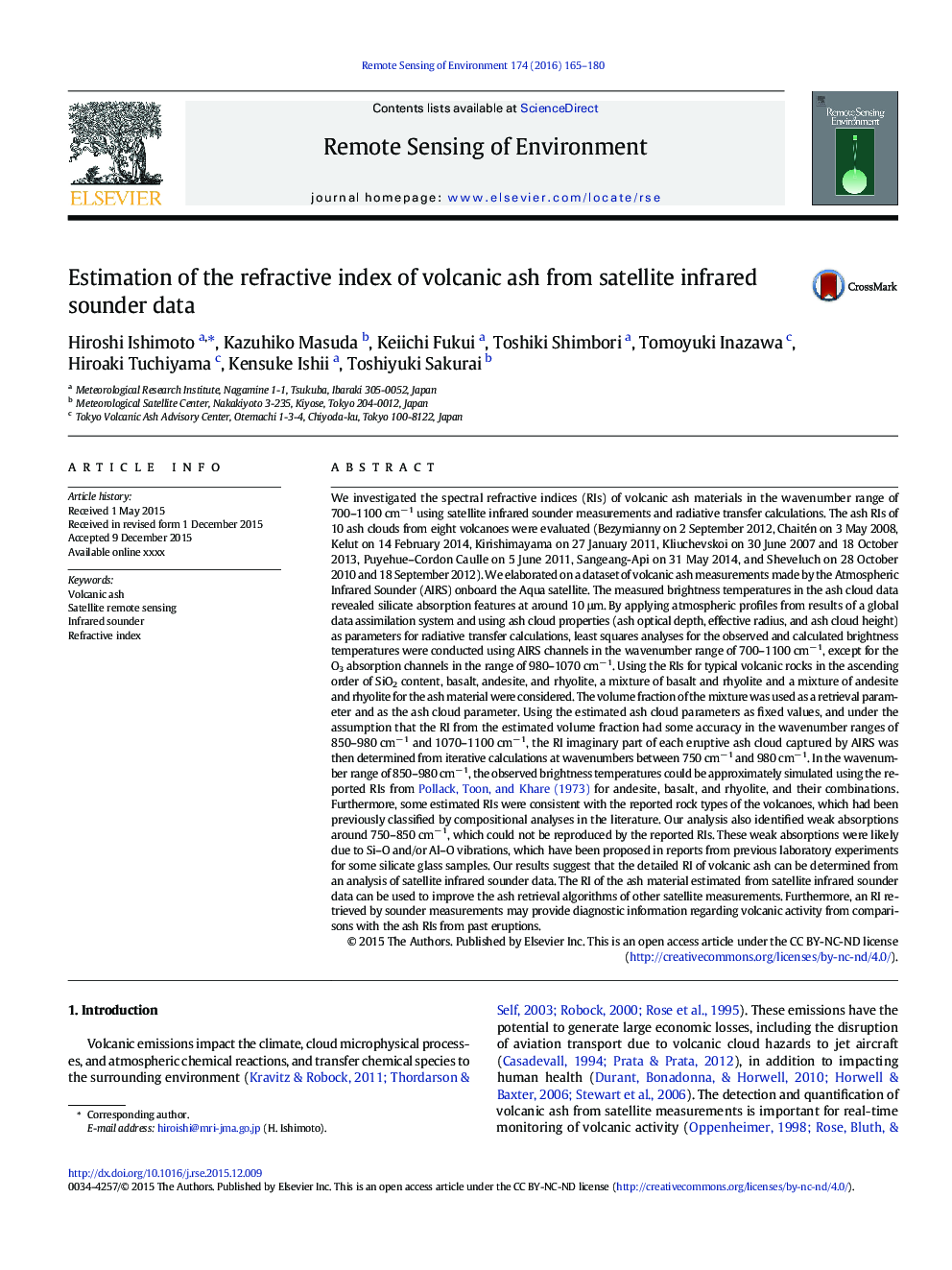| کد مقاله | کد نشریه | سال انتشار | مقاله انگلیسی | نسخه تمام متن |
|---|---|---|---|---|
| 6345564 | 1621226 | 2016 | 16 صفحه PDF | دانلود رایگان |
عنوان انگلیسی مقاله ISI
Estimation of the refractive index of volcanic ash from satellite infrared sounder data
ترجمه فارسی عنوان
برآورد شاخص شکستن خاکستر آتشفشانی از داده های ماهواره ای مادون قرمز ماهواره ای
دانلود مقاله + سفارش ترجمه
دانلود مقاله ISI انگلیسی
رایگان برای ایرانیان
کلمات کلیدی
خاکستر آتشفشانی، سنجش از راه دور ماهواره، صدای مادون قرمز، ضریب شکست،
موضوعات مرتبط
مهندسی و علوم پایه
علوم زمین و سیارات
کامپیوتر در علوم زمین
چکیده انگلیسی
We investigated the spectral refractive indices (RIs) of volcanic ash materials in the wavenumber range of 700-1100 cmâ 1 using satellite infrared sounder measurements and radiative transfer calculations. The ash RIs of 10 ash clouds from eight volcanoes were evaluated (Bezymianny on 2 September 2012, Chaitén on 3 May 2008, Kelut on 14 February 2014, Kirishimayama on 27 January 2011, Kliuchevskoi on 30 June 2007 and 18 October 2013, Puyehue-Cordon Caulle on 5 June 2011, Sangeang-Api on 31 May 2014, and Sheveluch on 28 October 2010 and 18 September 2012). We elaborated on a dataset of volcanic ash measurements made by the Atmospheric Infrared Sounder (AIRS) onboard the Aqua satellite. The measured brightness temperatures in the ash cloud data revealed silicate absorption features at around 10 μm. By applying atmospheric profiles from results of a global data assimilation system and using ash cloud properties (ash optical depth, effective radius, and ash cloud height) as parameters for radiative transfer calculations, least squares analyses for the observed and calculated brightness temperatures were conducted using AIRS channels in the wavenumber range of 700-1100 cmâ 1, except for the O3 absorption channels in the range of 980-1070 cmâ 1. Using the RIs for typical volcanic rocks in the ascending order of SiO2 content, basalt, andesite, and rhyolite, a mixture of basalt and rhyolite and a mixture of andesite and rhyolite for the ash material were considered. The volume fraction of the mixture was used as a retrieval parameter and as the ash cloud parameter. Using the estimated ash cloud parameters as fixed values, and under the assumption that the RI from the estimated volume fraction had some accuracy in the wavenumber ranges of 850-980 cmâ 1 and 1070-1100 cmâ 1, the RI imaginary part of each eruptive ash cloud captured by AIRS was then determined from iterative calculations at wavenumbers between 750 cmâ 1 and 980 cmâ 1. In the wavenumber range of 850-980 cmâ 1, the observed brightness temperatures could be approximately simulated using the reported RIs from Pollack, Toon, and Khare (1973) for andesite, basalt, and rhyolite, and their combinations. Furthermore, some estimated RIs were consistent with the reported rock types of the volcanoes, which had been previously classified by compositional analyses in the literature. Our analysis also identified weak absorptions around 750-850 cmâ 1, which could not be reproduced by the reported RIs. These weak absorptions were likely due to Si-O and/or Al-O vibrations, which have been proposed in reports from previous laboratory experiments for some silicate glass samples. Our results suggest that the detailed RI of volcanic ash can be determined from an analysis of satellite infrared sounder data. The RI of the ash material estimated from satellite infrared sounder data can be used to improve the ash retrieval algorithms of other satellite measurements. Furthermore, an RI retrieved by sounder measurements may provide diagnostic information regarding volcanic activity from comparisons with the ash RIs from past eruptions.
ناشر
Database: Elsevier - ScienceDirect (ساینس دایرکت)
Journal: Remote Sensing of Environment - Volume 174, 1 March 2016, Pages 165-180
Journal: Remote Sensing of Environment - Volume 174, 1 March 2016, Pages 165-180
نویسندگان
Hiroshi Ishimoto, Kazuhiko Masuda, Keiichi Fukui, Toshiki Shimbori, Tomoyuki Inazawa, Hiroaki Tuchiyama, Kensuke Ishii, Toshiyuki Sakurai,
